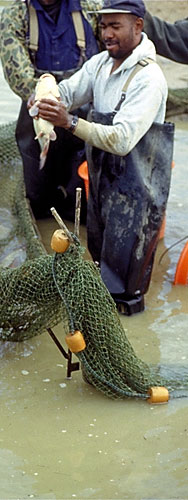|

|
Fish farmers in Virginia
earn more than $5 million each year from the fish they raise.
More than $2 million worth of trout
alone are raised and sold each year. Many farmers also raise catfish,
hybrid
striped bass,
Tilapia,
and goldfish.
Some producers
raise game
fish, such
as largemouth bass and bluegill, for stocking ponds and lakes.
Crayfish, bait minnows, and aquatic
plants are
also part of the freshwater aquaculture harvest.
There are four ways
freshwater fish are raised. Trout can be raised in long concrete
raceways
where there is plenty of fresh, cool, running water. Shallow farm
ponds
are used to grow many types of fish including catfish and hybrid
striped bass. Floating fish
cages are
used in deep ponds to grow several types of fish. The same ponds
can be used to grow catfish in the warm season and trout in the
winter. In areas where ponds are scarce, closed or recirculating
systems
are used. These are large tanks that use filtered water. Tilapia
and aquatic plants are often grown in closed systems.
In most cases, fish
are spawned in hatcheries
and raised to the
fingerling
size. The fingerlings are then sold to producers who raise the
fish to market size.
Raising fish can be
risky business. Bad weather, poor water quality, predators, and
disease can reduce or even wipe out an entire crop. Aquaculture
producers, just like traditional farmers, face many challenges
in getting their crop to market to make a living. The next time
you take a bite of farm-raised fish, think about what it takes
to get that delicious food to your plate.
|



